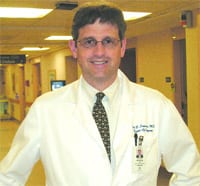Baystate Offers Caregivers Advice on Patient Safety
SPRINGFIELD — The ultimate healthcare experience can best be achieved when patients take an active role in their treatment by communicating with their healthcare team and asking questions.
“While that is the goal, it isn’t always possible — for example, when an elderly patient is suffering from hospital-related delirium,” said Dr. Doug Salvador, vice president of Medical Affairs in the Division of Healthcare Quality at Baystate Health. “In those cases, it’s best to have a family member or close friend to serve as your advocate … someone you trust who can ask those questions, take notes for you, and listen to what the doctors and nurses are saying.”
In an effort to raise awareness and encourage the engagement of patients, families, healthcare providers, and the public, the National Patient Safety Foundation (NPSF) recently marked Patient Safety Awareness Week. This year’s theme, “United in Safety,” stressed patient engagement and emphasizes the importance of the relationship between providers and patients and their families.
According to Dr. Rebecca Starr of the Geriatrics, Palliative Care & Post-Acute Medicine Division at Baystate Medical Center, it is estimated that delirium — a severe case of mental confusion, often temporary, which, if not addressed, can lead to long-term impaired cognition, post-operative complications, and longer hospital stays — can affect as many as half of the elderly patients in a hospital, especially those undergoing surgery, who are hospitalized in the intensive care unit or who have pre-existing dementia. It can also be caused by a number of factors such as medications like painkillers or sedatives, infection, dehydration, isolation, and poor nutrition.
According to Starr, studies have shown it is possible to sometimes prevent delirium in elderly hospitalized patients. She said family members and caregivers can help reduce someone’s risk of developing it by:
• Making sure caregivers are getting the patient out of bed and walking him or her several times daily. If the patient is able to walk safely with assistance, take short walks with him or her in the hallway. Also, talk to caregivers about the use of any physical restraints, which may contribute to delirium.
• Bringing a clock into the room if there isn’t one, as well as a visible calendar, so the patient doesn’t lose track of time and become disoriented.
• Making sure the patient has access to their hearing aids and eyeglasses, which are especially important when engaging them in word games, reading, and other activities to maintain cognition and avoid disorientation.
• Keeping the patient hydrated because dehydration can contribute to delirium. Ask hospital staff to keep the water pitcher filled so, if not limited in how much they can drink, the patient can drink up to six glasses of water daily. If they aren’t drinking, encourage them to drink when visiting. Consider, with permission of staff, bringing in special sodas, juices, or other beverages the patient enjoys.
• Asking staff to create a positive sleep environment by minimizing waking the patient for things such as checking blood pressure or temperature or drawing blood. Many things can interfere with sleep while in the hospital, from noise to pain. Talk with hospital staff about other ways to help the patient sleep, rather than using sleeping pills, which can contribute to delirium in elderly patients.
• Reviewing the hospitalized patient’s medications with doctors. Many prescription drugs, from narcotics to cardiac medications, can contribute to delirium.
Recognizing that, in the geriatric population, being removed from one’s home surroundings can be disorienting, and striving to create a healing environment for their patients, staff on the Springfield 3 medical unit at Baystate Medical Center — including an interdisciplinary group of doctors, physician assistants, registered nurses, patient-care technicians, pharmacists, physical therapists, data analysts and others — are participating in a pilot project to improve outcomes for older patients.



Comments are closed.